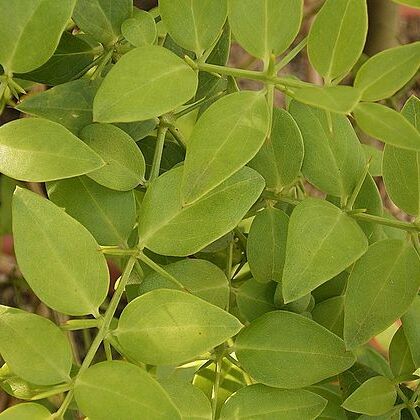Shrubs erect or scrambling, glabrous, much branched, smelling rancid when rubbed; spines 1 or 2, axillary. Stipules very small. Leaves opposite, entire. Flowers small, unisexual (plants usually dioecious) or sometimes partially bisexual; pedicels absent or very short. Calyx campanulate, 4-fid or irregularly 2-4-lobed in female flowers. Petals 4, free, oblong or lanceolate. Male flowers: stamens longer than petals; filaments linear, free or with coherent bases; ovary rudimentary or absent. Female flowers: stamens reduced, sterile, shorter than petals; ovary globose, 2-locular or imperfectly 4-locular; stigma 2-fid, subsessile. Bisexual flowers as in females but with 4 fertile stamens. Berry globose or ovoid, 1-or 2(or 3)-seeded; endocarp thin, membranous. Seeds globose, compressed, with a thick, leathery testa.
Glabrous or pubescent dioecious shrubs; stems much branched, sometimes rather scrambling, armed with paired or solitary axillary spines. Flowers small, axillary. Calyx campanulate, shortly 4-toothed or 2-partite. Petals 4, free, lanceolate. Male flowers: stamens 4, free, slightly exserted, alternating with the petals; anthers oblong, nearly equalling the linear filaments; ovary rudimentary. Female flowers: staminodes 4, alternating with the petals; rudimentary anthers sagittate at the base; ovary ovoid, 2-locular; ovules basal, 1–2 per locule but usually solitary; stigma sessile, bilobed, hairy. Fruit a berry, 1–2-seeded.
Female flowers: staminoides 4, alternating with the petals; ovary ovoid, 2–locular; ovules basal, 1 (or more rarely 2) per locule; stigma sessile, bilobed hairy.
Male flowers: stamens 4, free, slightly exserted, alternating with the petals; anthers oblong, nearly equalling the filaments; ovary rudimentary.
Glabrous or pubescent dioecious shrubs or small trees; stems much branched, bearing paired or solitary axillary spines.
Calyx campanulate, shortly 4–toothed or 2–partite.
Fruit a berry 1–(more rarely 2–) seeded.
Petals 4, free, lanceolate.
Leaves opposite, simple.
Flowers small, axillary.

